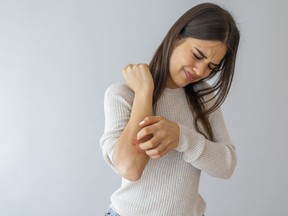Health
Researchers Discover Effective Method to Alleviate Itch Without Scratching

Itching is a common discomfort many experience, but recent research has revealed that avoiding scratching can lead to more effective relief. Instead, gentle rubbing or stroking the skin can effectively soothe an itch. This method can be particularly beneficial for managing irritations caused by bug bites or skin conditions like psoriasis.
In a groundbreaking study conducted in 2020, a team led by Tasuku Akiyama, an associate professor of dermatology and cutaneous surgery at the University of Miami Miller School of Medicine, explored the body’s response to rubbing an itchy area. The researchers discovered that applying a gentle stroke to the skin of mice effectively interrupted the itch signal, preventing it from reaching the brain.
Akiyama noted, “Once you start scratching, sometimes you can’t stop. It’s called the ‘itch-scratch cycle.’ If you can resist it, you probably should resist it. Otherwise, there’s rubbing.” This suggests that rubbing the skin can provide significant relief without the potential for further irritation associated with scratching.
A subsequent study in 2021 examined the impact of a soft makeup brush on itch relief. Involving 61 participants, researchers induced an itchy sensation using electricity on their arms. The results indicated that gently stroking the area with the brush at a rate of approximately 1 inch per second offered about 12 percent more relief compared to faster strokes at 7 inches per second. This reinforces the idea that a gentle touch is more effective in combating itchiness.
Understanding the Science Behind Itching
Both pain and itch sensations are transmitted via the same thin, slow-moving nerve fibers. Histamine, commonly associated with allergic reactions, is a well-known trigger for itchiness. Other factors, such as contact with certain materials, can also provoke this sensation. For example, a smooth cotton shirt typically does not cause discomfort, while a rough wool fabric might lead to an itchy response due to its texture.
This phenomenon is explained by the spatial contrast theory of itching, which suggests that localized activation of nerve fibers creates the perception of itch. If the nerve activation is too intense or widespread, it is interpreted as pain instead.
The Ineffectiveness of Scratching
While scratching can provide immediate relief, it often exacerbates the itch. When the skin is scratched, it can trigger the release of inflammatory molecules, which may cause the itch to return, leading to a cycle of discomfort. Rubbing, on the other hand, alleviates the spatial contrast that triggers the itch without damaging the skin.
Patients with chronic itch conditions, such as those undergoing hemodialysis or suffering from urticaria, often opt to rub their skin rather than scratch it. This observation has prompted further investigations into the benefits of rubbing as a means of itch relief.
The phenomenon of itchiness can even be contagious. Research has shown that merely witnessing videos of people scratching or seeing insects can evoke an itch response in observers.
As more studies reveal effective alternatives to scratching, individuals experiencing itchiness can now consider gentle rubbing as a viable option. This approach not only provides relief but also minimizes potential skin damage associated with scratching.
For ongoing health news and insights into various conditions, wellness, and treatments, visit Healthing.ca, part of the Postmedia Network.
-

 Science3 months ago
Science3 months agoToyoake City Proposes Daily Two-Hour Smartphone Use Limit
-

 Top Stories3 months ago
Top Stories3 months agoPedestrian Fatally Injured in Esquimalt Collision on August 14
-

 Health3 months ago
Health3 months agoB.C. Review Reveals Urgent Need for Rare-Disease Drug Reforms
-

 Technology3 months ago
Technology3 months agoDark Adventure Game “Bye Sweet Carole” Set for October Release
-

 World3 months ago
World3 months agoJimmy Lai’s Defense Challenges Charges Under National Security Law
-

 Lifestyle3 months ago
Lifestyle3 months agoVictoria’s Pop-Up Shop Shines Light on B.C.’s Wolf Cull
-

 Technology3 months ago
Technology3 months agoKonami Revives Iconic Metal Gear Solid Delta Ahead of Release
-

 Technology3 months ago
Technology3 months agoApple Expands Self-Service Repair Program to Canada
-

 Technology3 months ago
Technology3 months agoSnapmaker U1 Color 3D Printer Redefines Speed and Sustainability
-

 Technology3 months ago
Technology3 months agoAION Folding Knife: Redefining EDC Design with Premium Materials
-

 Business3 months ago
Business3 months agoGordon Murray Automotive Unveils S1 LM and Le Mans GTR at Monterey
-

 Technology3 months ago
Technology3 months agoSolve Today’s Wordle Challenge: Hints and Answer for August 19









